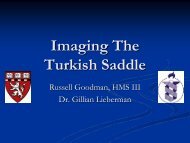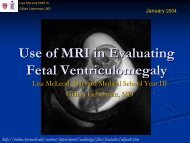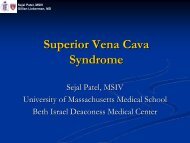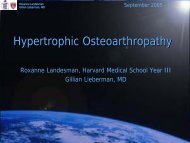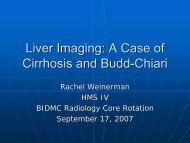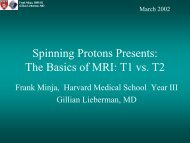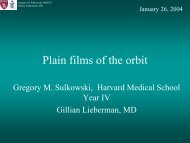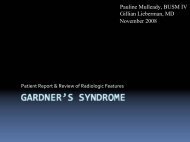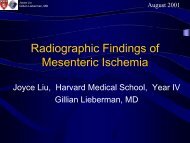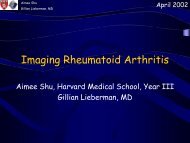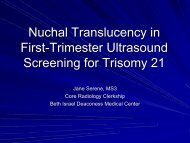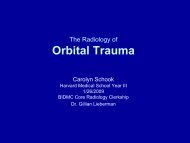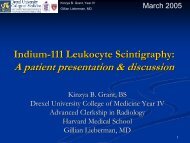Xanthogranulomatous cholecystitis vs Gallbladder carcinoma
Xanthogranulomatous cholecystitis vs Gallbladder carcinoma
Xanthogranulomatous cholecystitis vs Gallbladder carcinoma
Create successful ePaper yourself
Turn your PDF publications into a flip-book with our unique Google optimized e-Paper software.
<strong>Xanthogranulomatous</strong><br />
Cholecystitis:<br />
Ultrasound, CT, and MRI findings<br />
Ultrasound<br />
CT<br />
Julia T. Chu, HMS IV<br />
Laura Avery, M.D.<br />
Gillian Lieberman, M.D.<br />
MRI
•<br />
•<br />
•<br />
•<br />
•<br />
•<br />
•<br />
Patient:<br />
DDx: RUQ abd<br />
Agenda<br />
53yo M with RUQ abd<br />
pain<br />
pain<br />
Imaging Modalities: available to image our patient<br />
Radiologic Findings:<br />
US, CT, MRI<br />
gangrenous <strong>cholecystitis</strong>, adenomyomatosis<br />
review of anatomy and pathophysiology<br />
Pathology Dx: <strong>Xanthogranulomatous</strong><br />
Management: Depends on radiologic Dx!<br />
Take-Home Points<br />
<strong>cholecystitis</strong>
•<br />
•<br />
•<br />
•<br />
•<br />
•<br />
Our Patient:<br />
History & Physical Exam<br />
Hx: 53yo M with intermittent RUQ abd pain for 2<br />
years; no fever/chills, nausea/vomiting, weight<br />
loss, or food association<br />
PMH:<br />
Meds:<br />
SH:<br />
Exam:<br />
Labs:<br />
DM 2, hyperlipidemia, HTN<br />
Metformin, ASA, lisinopril, atorvastatin<br />
Plumber married w/ children;<br />
(+) smoking, (-) EtOH<br />
(+) Murphy sign, (+) guaiac<br />
Leukocytosis, ↑<br />
Alk<br />
Phos, ↑<br />
LFTs, ↑<br />
GGT
Vascular<br />
Infarct<br />
Pyelophlebitis<br />
Mesenteric thrombosis<br />
Adrenal infarct<br />
Occlusion<br />
Embolism<br />
Clinical DDx:<br />
RUQ abd<br />
(by mnemonic)<br />
pain<br />
“V I N D I C A T E”<br />
Neoplasm<br />
Degenerative<br />
Renal vein thrombosis<br />
Inflammation/Infection Carcinoma<br />
Osteoarthritis<br />
Cellulitis, Osteomyelitis Cholangioma<br />
Diaphragmatic abscess Pancreatic <strong>carcinoma</strong><br />
Trichinosis, TB, Herpes zoster Hodgkin disease<br />
Hepatitis, Hepatic abscess<br />
Cholecystitis, Cholangitis<br />
Lymphosarcoma<br />
Neuroblastoma<br />
Intoxication/<br />
Idiopathic<br />
Duodenitis, Diverticulitis, Colitis Adrenal <strong>carcinoma</strong><br />
Alcoholic hepatitis<br />
Pancreatitis, Pyelonephritis Multiple myeloma<br />
Ulcer<br />
Ulcer, Mesenteric adenitis<br />
Gout<br />
Waterhouse-Friderichsen syndrome<br />
Allergic/<br />
Autoimmune<br />
Rheumatoid<br />
spondylitis<br />
Congenital/<br />
Acquired<br />
Anomaly<br />
Ventral hernia<br />
Incisional<br />
hernia<br />
Diverticulum<br />
Obstruction<br />
Cyst<br />
Hydronephrosis<br />
Endocrine<br />
Hyperparathyroidism<br />
Trauma<br />
Contusion<br />
Cough<br />
Hemorrhage<br />
Laceration<br />
Rupture<br />
Herniated disc<br />
Spine fracture
DDx:<br />
<strong>Gallbladder</strong> <strong>carcinoma</strong><br />
Cholecystitis<br />
and<br />
cholelithiasis<br />
Hepatic flexure<br />
syndrome<br />
Carcinoma of the colon<br />
with obstruction<br />
Pancreatitis<br />
Colitis Thus, would involve which conditions?<br />
Diverticulitis<br />
Pancreatic calculus<br />
Pyelonephritis<br />
Embolic nephritis<br />
Carcinoma<br />
Subphrenic abscess<br />
Hepatitis<br />
Liver abscess<br />
RUQ abd<br />
(by anatomy)<br />
Pneumonia/empyema pleurisy<br />
pain<br />
Budd-Chiari syndrome<br />
Our patient’s main DDx, based on:<br />
RUQ pain<br />
(+) Murphy Sign<br />
leukocytosis,<br />
Renal calculus<br />
Legend: Liver Pancreas<br />
Bile duct Small bowel<br />
<strong>Gallbladder</strong> Large Bowel<br />
Renal System Others<br />
Laceration<br />
Cholangitis<br />
Common duct stone<br />
Duodenal ulcer<br />
would be most likely centered on which organ?<br />
Carcinoma of the<br />
pancreas<br />
www.wrongdiagnosis.com
•<br />
•<br />
•<br />
•<br />
•<br />
•<br />
Imaging Modalities:<br />
Available/Applicable to Our Patient<br />
with RUQ pain, ↑<br />
WBC, (+)Murphy<br />
Ultrasound (US): abdomen/gallbladder to look for gallstones, aneurysm<br />
Nuclear Medicine: cholescintigraphy (or HIDA scan) with or w/out<br />
cholecystokinin to evaluate the function of the gallbladder and the bile<br />
ducts<br />
X-ray: Upper GI series to rule out stomach/duodenum conditions;<br />
abdomen; colon barium enema; chest x-ray to rule out pneumonia<br />
Computed Tomography (CT): abdomen to further evaluate the<br />
gallbladder for mass/<strong>carcinoma</strong> as well as other abd organs such as the<br />
nearby pancreas<br />
Magnetic Resonance Imaging (MRI): T1 with fat saturation, T2 to<br />
assess soft tissue changes such as fluid, inflammation, edema; MR<br />
cholangiopancreatography (MRCP) to visualize the biliary tract and<br />
pancreatic ducts<br />
Invasive: cholangiography, percutaneous cholecystostomy, endoscopic<br />
retrograde cholangiopancreatography (ERCP)<br />
American College of Radiology, www.acr.org
Arrive at Our Dx, Step by Step …<br />
H&P:<br />
•<br />
•<br />
•<br />
Hx<br />
–<br />
Exam –<br />
RUQ abd<br />
pain<br />
(+) Murphy sign<br />
Labs – Leukocytosis<br />
Clinical DDx:<br />
• Cholecystitis<br />
• Cholelithiasis<br />
• Choledocholithiasis<br />
• Cholangitis<br />
• Hepatitis<br />
• Pancreatitis<br />
Imaging: Ultrasound
Normal Liver<br />
Our Patient:<br />
Findings on Ultrasound<br />
Sagittal<br />
<strong>Gallbladder</strong><br />
Courtesy of Dr. MaryEllen Sun (BIDMC PACS)<br />
Patient<br />
Hyperechoic fatty liver with<br />
abnormality in the region<br />
contiguous to gallbladder<br />
Abd aorta<br />
√ Marked irregular GB wall thickening<br />
√ Cholelithiasis with (+) US Murphy sign<br />
Film Findings: hyperechoic fatty liver, markedly thickened<br />
gallbladder wall, cholelithiasis with (+) US Murphy sign<br />
Impression: Gangrenous <strong>cholecystitis</strong> <strong>vs</strong> GB <strong>carcinoma</strong><br />
Sagittal<br />
Partners CAS
Arrive at Our Dx, Step by Step …<br />
H&P:<br />
• Hx – RUQ abd pain<br />
• Labs – Leukocytosis<br />
• Exam – (+) Murphy sign<br />
Clinical DDx:<br />
• Cholecystitis<br />
• Choledocholithiasis<br />
• Cholangitis<br />
• Hepatitis<br />
• Pancreatitis<br />
US Findings:<br />
• Irregular gallbladder wall<br />
thickening<br />
Imaging: CT to evaluate gallbladder wall<br />
thickening <strong>vs</strong> “mass”; why?<br />
• gallbladder <strong>carcinoma</strong> has a poor prognosis of<br />
85% mortality within 1 year of diagnosis<br />
• need to further evaluate the US findings with<br />
more imaging studies before embarking on any<br />
treatment<br />
US DDx:<br />
• Gangrenous <strong>cholecystitis</strong><br />
• <strong>Gallbladder</strong> <strong>carcinoma</strong>
Our Patient: Findings on CT scan<br />
Axial, oral C+<br />
Cystic structure<br />
Irregular wall thickening<br />
involving the gallbladder fundus<br />
<strong>Gallbladder</strong><br />
Fundus<br />
Cystic duct<br />
Neck<br />
Body<br />
Common<br />
hepatic<br />
duct<br />
Common<br />
bile duct<br />
www.wiltshiresurgery.com<br />
Heterogeneous low density in the adjacent liver<br />
Film Findings: Irregularly thickened wall at the gallbladder<br />
fundus, low attenuation in liver adjacent to the gallbladder, cyst<br />
at the fundus.<br />
Partners CAS
Our Patient: Pertinent negative<br />
findings on CT scan<br />
Coronal, oral and IV C+<br />
Cystic structure<br />
Irregular wall thickening<br />
involving the gallbladder fundus<br />
No pericholecystic<br />
No intra or extrahepatic<br />
fluid or inflammation<br />
biliary<br />
ductal<br />
No wall thickening in the inferior and<br />
medial aspect of the gallbladder<br />
Partners CAS<br />
dilatation<br />
Impression: CT findings suspicious for malignancy. Infection<br />
much less likely given no pericholecystic fluid or inflammation.
Arrive at Our Dx, Step by Step …<br />
H&P:<br />
•<br />
•<br />
•<br />
Hx<br />
–<br />
Labs –<br />
Exam –<br />
RUQ abd<br />
pain<br />
Leukocytosis<br />
(+) Murphy sign<br />
Clinical DDx:<br />
• Cholecystitis<br />
• Choledocholithiasis<br />
• Cholangitis<br />
• Hepatitis<br />
• Pancreatitis<br />
US Findings:<br />
• Irregular gallbladder wall<br />
thickening<br />
Imaging: MR to further evaluate soft tissue<br />
changes in the gallbladder and the adjacent<br />
liver to assess inflammatory changes and<br />
confirm or rule out malignancy<br />
CT DDx: gallbladder malignancy<br />
CT Findings:<br />
• Irregular wall thickening at the gallbladder fundus<br />
• Cystic structure at the gallbladder fundus<br />
• No pericholecystic fluid or inflammation<br />
• No biliary ductal dilatation<br />
US DDx:<br />
• Gangrenous <strong>cholecystitis</strong><br />
• <strong>Gallbladder</strong> <strong>carcinoma</strong>
Our Patient:<br />
Findings on MR imaging<br />
Axial T1-weighted Gradient Echo with Fat Sat;<br />
Post-Gadolinium<br />
Arterial Phase<br />
Partners CAS<br />
Axial T1-weighted Hi-Resolution with Fat Sat;<br />
Post-Gadolinium<br />
Slight enhancement of GB wall mucosa, most<br />
prominently involving the fundal portion<br />
Partners CAS<br />
Film Findings: Wall thickening thickened along the gallbladder fundus measuring wall with up hyper-intensity<br />
of the mucosa to 15mm in mostly maximum involving thickness the fundus
Our Patient:<br />
Findings on MR imaging<br />
Axial T1-weighted Gradient Echo with Fat Sat;<br />
Post-Gadolinium,<br />
Arterial Phase<br />
Partners CAS<br />
Axial T1-weighted Hi-Resolution with Fat Sat;<br />
Post-Gadolinium<br />
No clear communication between the fundus and<br />
this cystic collection could be demonstrated<br />
Partners CAS<br />
Film Findings: Small small cystic cyst area at adjacent the fundus to the fundus with ? communication to<br />
the gallbladder measuring that cannot up to 2.0 be cm, clearly (+) rim identified enhancement on MR
Axial T2-weighted with Fat Saturation<br />
Our Patient:<br />
Findings on MR imaging<br />
Irregular wall thickening<br />
involving the gallbladder fundus<br />
Partners CAS<br />
Coronal T2-weighted Single-Shot Fast Spin Echo<br />
(SSFSE)<br />
<strong>Gallbladder</strong> sludge and stones<br />
Film Findings: Gallstones and, again, irregularly thickened<br />
gallbladder wall involving the fundus<br />
Partners CAS
Our Patient:<br />
Findings on MR imaging<br />
Coronal 2D Thick-Slab Abdomen<br />
(MR Cholangiopancreatography, or MRCP)<br />
Right hepatic duct<br />
Cystic duct<br />
<strong>Gallbladder</strong><br />
Major duodenal papilla<br />
Left hepatic duct<br />
Common hepatic duct<br />
Common bile duct<br />
Pancreatic duct<br />
Hepatopancreatic<br />
R and L<br />
hepatic Common ducts<br />
Cystic<br />
Common<br />
duct<br />
<strong>Gallbladder</strong><br />
Co<br />
Main pancreatic duct<br />
Com<br />
Hepatopancreatic ampulla<br />
Com<br />
Major duodenal papilla<br />
ampulla Com<br />
(4)<br />
Common<br />
hepatic Gallbladde duct<br />
r<br />
<strong>carcinoma</strong><br />
Common<br />
Common<br />
bile duct<br />
Film Findings: No biliary/pancreatic duct obstruction/dilatation<br />
Duodenum<br />
Duodenum<br />
Com<br />
Partners CAS<br />
Copyright ® The McGraw-Hill Companies, Inc.<br />
Impression: Normal biliary/pancreatic http://academic.kellogg.cc.mi.us/herbrandsonc/bio201 ductal system.<br />
McKinley/Digestive%20System.htm<br />
(2)<br />
(1)<br />
(3)
R and L<br />
hepatic Common ducts<br />
Common Cystic duct<br />
Co<strong>Gallbladder</strong><br />
The Biliary<br />
Main pancreatic duct<br />
Com<br />
Hepatopancreatic ampulla<br />
Com<br />
Major duodenal papilla<br />
Com<br />
Duodenum<br />
Com<br />
(2)<br />
(4)<br />
(1)<br />
Copyright ® The McGraw-Hill Companies, Inc.<br />
Quick Review:<br />
Common <strong>Gallbladder</strong><br />
hepatic <strong>carcinoma</strong> duct<br />
Common<br />
Common<br />
bile duct<br />
(3)<br />
and Pancreatic Ducts<br />
(1) R and L hepatic ducts merge to<br />
form a common hepatic duct<br />
(2)<br />
(3)<br />
(4)<br />
http://academic.kellogg.cc.mi.us/herbrandsonc/bio201_McKinley/Digestive%20System.htm<br />
Common hepatic and cystic<br />
ducts merge to form a common<br />
bile duct<br />
Pancreatic duct merges with<br />
common bile duct at the<br />
hepatopancreatic ampulla<br />
Bile and pancreatic juices<br />
enter duodenum at the major<br />
duodenal papilla
Our Patient:<br />
Findings on MR imaging<br />
Axial T2-weighted with Fat Saturation<br />
↑ T2 signal abnormality (hyper-intensity) surrounding the<br />
gallbladder and adjacent liver parenchyma<br />
No enlarged lymph nodes.<br />
Patent hepatic vasculature.<br />
No ascites.<br />
Film Findings: ↑ T2 signal surrounding the fundus, patent hepatic<br />
Partners CAS<br />
vasculature, no lymphadenopathy or ascities<br />
Impression: Overall MRI findings suggestive of fatty infiltration,<br />
adenomyomatosis likely complicated by chronic <strong>cholecystitis</strong>;<br />
gallbladder adeno<strong>carcinoma</strong> cannot be entirely excluded.
•<br />
•<br />
MRI Dx:<br />
What is<br />
Adenomyomatosis?<br />
Definition: benign, abnormal<br />
though non-premalignant<br />
gallbladder mucosal<br />
hyperplasia, muscular wall<br />
thickening, and formation of<br />
intramural diverticula or sinus<br />
tracts called Rokitansky-<br />
Aschoff sinuses<br />
Radiologic Finding: Pearl<br />
Necklace Sign<br />
Very Very small small cystic cystic structures structures<br />
(Pearl (Pearl Necklace Necklace Sign) Sign)<br />
Multiple<br />
gallbladder stones<br />
uodenum<br />
Haradome, H. et al. Radiology 2003. 227(1): 80-8.
Arrive at Our Dx, Step by Step …<br />
H&P:<br />
•<br />
•<br />
•<br />
Hx<br />
–<br />
Labs –<br />
Exam –<br />
RUQ abd<br />
pain<br />
Leukocytosis<br />
(+) Murphy sign<br />
Clinical DDx:<br />
• Cholecystitis<br />
• Choledocholithiasis<br />
• Cholangitis<br />
• Hepatitis<br />
• Pancreatitis<br />
US DDx:<br />
• Gangrenous <strong>cholecystitis</strong><br />
• <strong>Gallbladder</strong> <strong>carcinoma</strong><br />
Pathology/Management: Open<br />
cholecystectomy to make the definitive,<br />
final Dx by histology and determine future<br />
management of our patient<br />
MR DDx:<br />
• Adenomyomatosis<br />
• <strong>Gallbladder</strong> adeno<strong>carcinoma</strong><br />
MR Findings:<br />
• Thickened gallbladder wall<br />
• Fundus cyst with ?communication<br />
• <strong>Gallbladder</strong> stones<br />
• No biliary obstruction/dilatation<br />
• ↑ T2 signal surrounding the fundus<br />
CT DDx: gallbladder malignancy
Our Companion Patient:<br />
Findings on Gross Pathology<br />
Cross section of the resected<br />
gallbladder<br />
Serosa covered with dense<br />
fibrous adhesions<br />
Gross Pathology Findings:<br />
(1) fibrosis and wall thickening<br />
(2) disruption of gallbladder wall<br />
(3) xanthogranulomatous foci<br />
Disruption of the gallbladder wall<br />
Ulcerated mucosal surface<br />
Diffuse wall thickening<br />
Yellow nodules/plaques, or<br />
xanthogranulomatous<br />
foci, extend into<br />
adjacent liver through the wall<br />
Levy, A. et al. Radiographics. 2002. 22(2): 387-413.
H&E stain<br />
Our Companion Patients:<br />
Thickened, fibrotic wall<br />
Levy, A. et al. Radiographics. 2002. 22(2): 387-413.<br />
Findings on Histology<br />
Lipid-laden mø: 2 morphological types<br />
Fibroblasts,<br />
inflammatory cells<br />
<strong>Xanthogranulomatous</strong><br />
<strong>cholecystitis</strong><br />
focus (blackarrows<br />
( blackarrows above)<br />
Contains:<br />
(1) bile pigment<br />
(2) chronic inflammatory cells<br />
(3) foamy pigment-laden macrophages (mø)<br />
Spindle-shaped Spindle shaped cells<br />
with more granular<br />
cytoplasm and<br />
elongated nuclei<br />
(1)<br />
(2)<br />
Rounded foamy<br />
macrophages<br />
Varadarajulu S, et al. Up-to-Date<br />
No dysplasia or malignancy!
Arrive at Our Dx, Step by Step …<br />
H&P:<br />
•<br />
•<br />
•<br />
Hx<br />
–<br />
Labs –<br />
Exam –<br />
RUQ abd<br />
pain<br />
Leukocytosis<br />
(+) Murphy sign<br />
Clinical DDx:<br />
• Cholecystitis<br />
• Choledocholithiasis<br />
• Cholangitis<br />
• Hepatitis<br />
• Pancreatitis<br />
US DDx:<br />
• Gangrenous <strong>cholecystitis</strong><br />
• <strong>Gallbladder</strong> <strong>carcinoma</strong><br />
Pathology (Final) Dx:<br />
<strong>Xanthogranulomatous</strong><br />
<strong>cholecystitis</strong><br />
Gross/Histologic Findings:<br />
• Wall thickening with fibrotic serosa<br />
• <strong>Xanthogranulomatous</strong> foci<br />
• Bile extravasation through disrupted wall<br />
• Lipid-laden macrophages<br />
• Chronic inflammatory cells<br />
MR DDx:<br />
• Adenomyomatosis<br />
• <strong>Gallbladder</strong> adeno<strong>carcinoma</strong><br />
CT DDx: gallbladder malignancy
Dx:<br />
What is<br />
<strong>Xanthogranulomatous</strong><br />
•<br />
•<br />
•<br />
Cholecystitis?<br />
Definition: unusual form of benign, chronic<br />
<strong>cholecystitis</strong> with focal or diffuse destructive<br />
inflammatory process<br />
Signs and symptoms: RUQ abd pain, fever,<br />
leukocytosis, vomiting, (+) Murphy sign<br />
Hallmarks:<br />
(1) thickened, fibrotic, disrupted gallbladder wall<br />
(2) foamy histiocytes<br />
(3) bile extravasation
Dx:<br />
What is<br />
<strong>Xanthogranulomatous</strong><br />
•<br />
Cholecystitis?<br />
Pathophysiology: gallbladder or cystic<br />
duct obstruction ↑ gallbladder<br />
intraluminal pressure rupture of<br />
Rokitansky-Aschoff sinuses or mucosal<br />
ulceration extravasation of bile into the<br />
gallbladder wall<br />
s63.4x1.jpg<br />
s63.jpg<br />
bile<br />
bile<br />
s63.jpg<br />
http://anatomy.iupui.edu/courses/histo_D502/D502f04/Labs.f04/digestive%20III%20lab/Lab13index.htm
•<br />
•<br />
•<br />
Management:<br />
<strong>Xanthogranulomatous</strong><br />
Significance of<br />
Cholecystitis<br />
Significance: may simulate malignancy clinically,<br />
radiologically, and pathologically<br />
Management of XG <strong>cholecystitis</strong>: open<br />
cholecystectomy with complete resection of the<br />
gallbladder due to dense fibrosis, extensive<br />
inflammation, ?coexistent malignancy<br />
Management of GB <strong>carcinoma</strong>:<br />
(1) aggressive surgery – partial/segmental hepatic<br />
resection or Whipple procedure<br />
(2) no resection at all with chemo/radiation instead
•<br />
•<br />
•<br />
Take Home Points:<br />
XG <strong>cholecystitis</strong>: benign yet focally/diffusely<br />
destructive inflammatory gallbladder disease<br />
with (1) fibrosis and wall thickening, (2) bile<br />
extravasation, (3) lipid-laden mø, (4)<br />
acute/chronic inflammatory cells<br />
XG <strong>cholecystitis</strong><br />
<strong>vs</strong> GB <strong>carcinoma</strong>:<br />
Patients<br />
with <strong>carcinoma</strong> are more likely to present with<br />
anorexia, weight loss, palpable mass, and<br />
jaundice<br />
Preoperative Dx<br />
by radiographs:<br />
may<br />
significantly alter therapy and patient prognosis<br />
– be careful!
•<br />
•<br />
•<br />
What happened to Our Patient?<br />
Our patient underwent an exploratory<br />
laparoscopy that was converted to open<br />
cholecystectomy, which went successfully<br />
without any complications<br />
His gallbladder was diagnosed with<br />
xanthogranulomatous <strong>cholecystitis</strong> without<br />
any associated malignancy by pathology<br />
and histology<br />
Our patient is alive and well as of today in<br />
June, 2008
•<br />
•<br />
•<br />
•<br />
•<br />
Acknowledgements<br />
Gillian Lieberman, M.D.<br />
Laura Avery, M.D.<br />
James Kang, M.D. (resident)<br />
Karen Lee, M.D. (fellow)<br />
Maryellen Sun, M.D. (fellow)
References<br />
Chun KA, Ha HK, Yu ES, Shinn KS, Kim KW, Lee DH, Kang SW, Auh YH. <strong>Xanthogranulomatous</strong><br />
<strong>cholecystitis</strong>: CT features with emphasis on differentiation from gallbladder <strong>carcinoma</strong>. Radiology. 1997<br />
Apr; 203(1): 93-7.<br />
Guermazi A. Are there other imaging features to differentiate xanthogranulomatous <strong>cholecystitis</strong> from<br />
gallbladder <strong>carcinoma</strong>? Eur Radiol. 2005 Jun; 15(6): 1271-2.<br />
Haradome H, Ichikawa T, Sou H, Yoshikawa T, Nakamura A, Araki T, Hachiya J. The pearl necklace sign:<br />
an imaging sign of adenomyomatosis of the gallbladder at MR cholangiopancreatography. Radiology.<br />
2003 Apr; 227(1): 80-8.<br />
Levy AD, Murakata LA, Rohrmann CA Jr. <strong>Gallbladder</strong> <strong>carcinoma</strong>: radiologic-pathologic correlation.<br />
Radiographics. 2001 Mar-Apr; 21(2): 295-314.<br />
Levy AD, Murakata LA, Abbott RM, Rohrmann CA Jr. From the archives of the AFIP. Benign tumors and<br />
tumorlike lesions of the gallbladder and extrahepatic bile ducts: radiologic-pathologic correlation. Armed<br />
Forces Institute of Pathology. Radiographics. 2002 Mar-Apr; 22(2): 387-413. Review.<br />
Shuto R, Kiyosue H, Komatsu E, Matsumoto S, Kawano K, Kondo Y, Yokoyama S, Mori H. CT and MR<br />
imaging findings of xanthogranulomatous <strong>cholecystitis</strong>: correlation with pathologic findings. Eur Radiol.<br />
2004 Mar; 14(3): 440-6.<br />
Srivastava M, Sharma A, Kapoor VK, Nagana Gowda GA. Stones from cancerous and benign gallbladders<br />
are different: A proton nuclear magnetic resonance spectroscopy study. Hepatol Res. 2008 May 27.<br />
Varadarajulu S, Zakko SF. <strong>Xanthogranulomatous</strong> <strong>cholecystitis</strong>. Up-to-date. 2007.<br />
Slides 16 and 17 –<br />
http://academic.kellogg.cc.mi.us/herbrandsonc/bio201_McKinley/Digestive%20System.htm<br />
Slide 25 –<br />
http://anatomy.iupui.edu/courses/histo_D502/D502f04/Labs.f04/digestive%20III%20lab/Lab13index.htm



